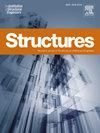Shear and flexural performance of an RPC wet joint in a prefabricated reinforced concrete structure
IF 3.9
2区 工程技术
Q1 ENGINEERING, CIVIL
引用次数: 0
Abstract
The shear and flexural performance of prefabricated reinforced concrete (RC) beams with reactive powder concrete (RPC)-based wet joints were experimentally investigated. The influences of parameters such as RPC wet joint type (monolithic, diagonal joint, double-keyed joint, or single-keyed joints) and joint slope were comparatively explored. Five shear specimens and eight flexural specimens were manufactured and tested. The crack pattern, load-deflection relationship, load–strain relationships between the load and strain, shear strength, flexural capacity, and deflection were investigated. The direct shear test results indicated that a diagonal joint without shear steel rebar was optimal joint type. The RPC wet joints with shear steel rebar could improved the interface bonding force ductility. A shear strength calculation model was developed to evaluate the shear performance of wet joints, Moreover, the effect of joint type was considered. The four-point bending test results revealed that the cracking resistance levels of the diagonal joint and single-keyed joints of the prefabricated RC beams were greater than that of the castellated joint. The optimal joint slope between diagonal strut and vertical direction was 45°. Two improved analytical models were developed to estimate the flexural capacity and deflection levels of prefabricated RC beams with different joint types and slopes. The proposed analytical models adequately agreed with the test data.
预制钢筋混凝土结构RPC湿缝抗剪抗弯性能研究
对活性粉末混凝土湿缝预制钢筋混凝土梁的抗剪和抗弯性能进行了试验研究。对比探讨了RPC湿节理类型(整体、对角、双键、单键)及节理坡度等参数的影响。制作并试验了5个剪切试件和8个弯曲试件。研究了裂缝形态、荷载-挠度关系、荷载与应变之间的荷载-应变关系、抗剪强度、抗弯能力和挠度。直剪试验结果表明,无剪力钢筋的斜缝是最优接缝形式。剪力钢筋RPC湿缝可提高界面黏结力延性。建立了湿节理抗剪强度计算模型,并考虑了节理类型对湿节理抗剪性能的影响。四点弯曲试验结果表明,预制混凝土梁对角节点和单键节点的抗裂水平高于槽形节点。对角支柱与垂直方向的最佳节理斜率为45°。建立了两种改进的分析模型来估计不同节点类型和坡度的预制RC梁的抗弯能力和挠度水平。所提出的分析模型与试验数据吻合较好。
本文章由计算机程序翻译,如有差异,请以英文原文为准。
求助全文
约1分钟内获得全文
求助全文
来源期刊

Structures
Engineering-Architecture
CiteScore
5.70
自引率
17.10%
发文量
1187
期刊介绍:
Structures aims to publish internationally-leading research across the full breadth of structural engineering. Papers for Structures are particularly welcome in which high-quality research will benefit from wide readership of academics and practitioners such that not only high citation rates but also tangible industrial-related pathways to impact are achieved.
 求助内容:
求助内容: 应助结果提醒方式:
应助结果提醒方式:


